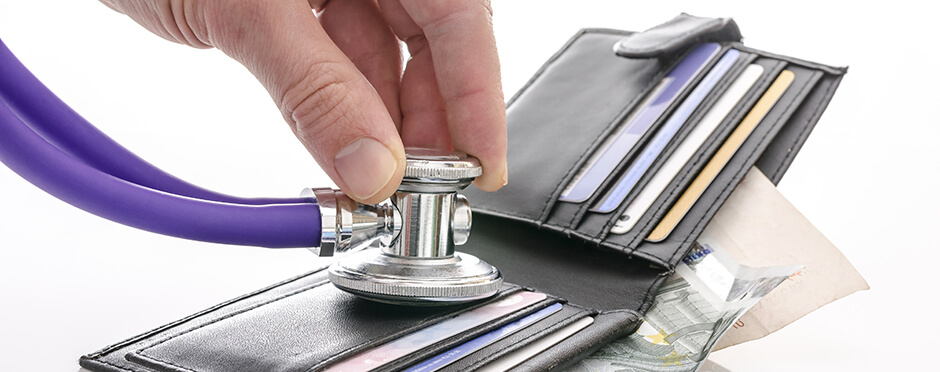
Financial well-being December 27, 2016 By
Would you like to have more control of your money…instead of your money controlling you? More than ever before, Americans are downing in debt. According to Experian’s National Score Index, at least one in ten consumers has more than 10 credit cards in their wallets; however, the overall average number of credit cards per consumer is four.1 The average balance for the American family is approximately $6,500 in credit card debt. How can you avoid being in this situation? By following some simple rules we will outline in this article, you can start improving your financial health today. And, over the next few months, we will discuss each step in more depth, but this will provide you with an overview as a “kick start” the process.
Step #1: Track Every Dollar You Spend
In order to “take control of your finances” you must get your expenses in order. To start, let’s track everything you spend for a month. It doesn’t matter how you track your spending, you just need to do it.
Some people track expenses automatically using a computerized money management program, such as Quicken or Microsoft Money. Others track their spending manually by saving receipts and entering them into a cash notebook. Whichever method you choose, stick with it, make it a habit and record your expenses as soon as possible.
This step is all about gathering data, not judging how you spend money or making drastic changes to your current money management habits. Once you start tracking your expenses, you may be more motivated to watch how you spend your money.
Step #2: Develop a Useful Budget
After you have collected information about your spending habits for a month, you should then develop a budget. Did you know that 55 percent of millionaires develop and live on a budget?2
Many people fail to live on a budget because it takes too much time, or it may be boring to create. Or, some just feel they don’t know how to do it. Developing a budget, though, is a great way to keep yourself focused on the financial goals you have determined to be important. In some instances, you will need to “cut the fat” in your spending habits. Maybe you will be limited in the number of times you eat out for lunch, or you can only go to a movie once a month. But, if you keep focused on the long-term goal of buying a home or enjoying a vacation with your family, those types of cuts may not seem as difficult to make.
Use caution, though, when you make cuts to your spending habits to make sure they are realistic. You do not want to make deep cuts in areas where you really need to spend money. For example, if you have a family of four, your food budget must take into account your entire family’s needs. Can you live on $250 a month for groceries? Will you be able to meet that budget or will you fail every month?
Be sure your budget can be met and that it is actually a useful tool in managing your family’s financial well-being.
Step #3: Start an Emergency Fund
Many people live paycheck-to-paycheck and figure they cannot save. That is not true. Everyone can save; it just takes discipline. As part of your budget, you need to develop an emergency fund for things like unexpected medical or vehicle expenses. Some experts recommend that once you have safely put together an emergency of fund of at least $1,000, you can move on to attacking your debt (which is the next step in our process).
But how can you create a fund when you are living so tightly month to month? Pay yourself first! The rule of thumb is to save approximately 10 percent of your gross income each month. The best way to do this is to set up an automatic transfer from your direct deposited paycheck. That way, you never see the money, and then you won’t spend it.
Step #4: Get Out of Debt
Debt is a killer when it comes to managing your finances. Maybe you struggle with heavy credit card debt, or even student loans. There is a method to help you eliminate the debt that you have, but you will need to be patient and consistent in this effort. First of all, list your debts from largest to smallest. Then, designate a fixed amount you will pay monthly toward each debt. Pay the minimum balance on all debts, except for the smallest balance; you should make a larger payment for that debt based on your balance. When the smallest debt is gone, work on the next smallest and so forth.
Once you begin to pay off your debt, you will feel an accomplishment that may motivate you to continue in the process and stay out of debt. The key is to really spend less than you make each month.
Step #5: Focus on Your Future
If you are young, you need to be focused on your future. Take time to set up a retirement account and even college funds for your children, and then pay into these accounts automatically each month. If you are not so young, you must be concerned about how you will manage in the future. Set up an account you can use for retirement and pay into it on a monthly basis. It is always better to have something prepared for your future than nothing at all.
The reality is that Social Security is not going to be what it is today for much longer, and expenses continue to rise for everyone. Being smart now will help you continue to live a similar (or even better) lifestyle to what you currently live.
Conclusion
Taking control of your finances can seem a little intimidating, but if you take things one step at a time, you will eliminate your financial stress and have more enjoyment in your life today. Look for more articles about each of these steps in future issues of Spend Life Wisely blogs.
This article was re-posted with permission. Sources:
- http://www.indexcreditcards.com/finance/creditcardtips/fistfuls-of-credit-cards-how-many-is-too-many.html
- The Millionaire Next Door, Thomas J. Stanley and William D. Danko Share this Article Tweet this Article




